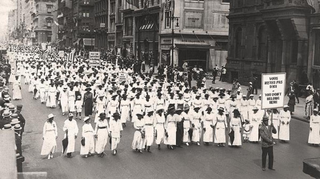1947 Sainte-Germaine riots
This article is incomplete because it is pending further input from participants, or it is a work-in-progress by one author. Please comment on this article's talk page to share your input, comments and questions. Note: To contribute to this article, you may need to seek help from the author(s) of this page. |
| 1947 Sainte-Germaine riots | |||
|---|---|---|---|
| Part of the Garamburan independence movement | |||
 Protestors wearing white to show solidarity with the movement | |||
| Date | March–April 1947 | ||
| Location | |||
| Caused by | |||
| Goals |
| ||
| Methods | Civil disobedience, destruction of property, mass protests, mass strikes, rioting, shootings | ||
| Resulted in |
| ||
| Parties to the civil conflict | |||
| |||
| Lead figures | |||
| Number | |||
| |||
| Casualties | |||
| |||
The 1947 Sainte-Germaine riots were a series of riots, acts of civil disobedience, protests and mass strikes that occurred in the city of Sainte-Germaine between March and April 1947. The riots were caused by the decolonisation policies of Estmere and the continued Rwizikuran sovereignty over Garambura, then known as the district of East Riziland. At their height, the riots included over 70,000 participants, as well as the controversial Républicains de l'Est group, who shot and killed four Rwizikuran soldiers. By the end of the riots, 36 were killed, over 1,000 injured and almost 2,500 demonstrators arrested. It is still the largest public demonstration in Garamburan history.
Background
The region of Garambura was historically settled and later colonised by Gaullica, absorbing it into the colony of Baséland. Neighbouring Rwizikuru was colonised by Estmere as Riziland, beginning vast cultural differences between the two states. The two massively diverged culturally as the Yebase rose to prominence in Garambura and the implementation of Gaullican and Estmerish in their respective colonies replaced the native veRwizi language, which was common between both places. Baséland was also characterised by his distinctively high white populace, implemented through decades of settlement in the area and eventually deviating into the separate Chennois demographic, which were highly influential in the colony.
By the time of the Great War, years of animosity between Functionalist Gaullica and the newly established Tripartite Pact of Estmere, Etruria and Werania made relations between the two bordering colonies extremely tense, and when war broke out in 1926, the Bahian front saw almost instantaneous conflict concentrated around the Maghedi Corridor, a narrow section of traversable land along the border due to the Makomo EkuMabvazuva mountains in north-eastern Rwizikuru. Fighting ensued until 1928 until the Tirailleurs Bahiennes of Gaullican Bahia eventually broke through and began to occupy Estmere's colonies as supplies from the mainland grew dry with Estmere's eventual collapse. With Gaullica and the Entente eventually losing the war, Gaullica's colonies were split temporarily between the Grand Alliance victors - with Baséland falling to Estmere and being administered as part of Riziland. Estmere made its decolonisation intent clear initially, however proposed plans outlined the secession of Riziland and Baséland as one country despite their cultural differences, which eventually went ahead when Rwizikuru got its independence in 1946.